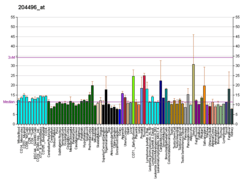STRN3
Striatin-3 is a protein that in humans is encoded by the STRN3 gene.[5][6][7]
Interactions
STRN3 has been shown to interact with:
gollark: My profile picture is DEFINITELY NOT subliminal pizza advertising.
gollark: FINALLY someone who doesn't assume it's pizza.
gollark: What?
gollark: ... no, that is probably not true.
gollark: This is more <#645777807275851776>-y.
References
- GRCh38: Ensembl release 89: ENSG00000196792 - Ensembl, May 2017
- GRCm38: Ensembl release 89: ENSMUSG00000020954 - Ensembl, May 2017
- "Human PubMed Reference:". National Center for Biotechnology Information, U.S. National Library of Medicine.
- "Mouse PubMed Reference:". National Center for Biotechnology Information, U.S. National Library of Medicine.
- Muro Y, Chan EK, Landberg G, Tan EM (Mar 1995). "A cell-cycle nuclear autoantigen containing WD-40 motifs expressed mainly in S and G2 phase cells". Biochem. Biophys. Res. Commun. 207 (3): 1029–37. doi:10.1006/bbrc.1995.1288. PMID 7864889.
- Moreno CS, Park S, Nelson K, Ashby D, Hubalek F, Lane WS, Pallas DC (Mar 2000). "WD40 repeat proteins striatin and S/G(2) nuclear autoantigen are members of a novel family of calmodulin-binding proteins that associate with protein phosphatase 2A". J. Biol. Chem. 275 (8): 5257–63. doi:10.1074/jbc.275.8.5257. PMC 3505218. PMID 10681496.
- "Entrez Gene: STRN3 striatin, calmodulin binding protein 3".
- Goudreault M, D'Ambrosio LM, Kean MJ, Mullin MJ, Larsen BG, Sanchez A, Chaudhry S, Chen GI, Sicheri F, Nesvizhskii AI, Aebersold R, Raught B, Gingras AC (Jan 2009). "A PP2A phosphatase high density interaction network identifies a novel striatin-interacting phosphatase and kinase complex linked to the cerebral cavernous malformation 3 (CCM3) protein". Mol. Cell. Proteomics. 8 (1): 157–71. doi:10.1074/mcp.M800266-MCP200. PMC 2621004. PMID 18782753.
- Ewing RM, Chu P, Elisma F, Li H, Taylor P, Climie S, McBroom-Cerajewski L, Robinson MD, O'Connor L, Li M, Taylor R, Dharsee M, Ho Y, Heilbut A, Moore L, Zhang S, Ornatsky O, Bukhman YV, Ethier M, Sheng Y, Vasilescu J, Abu-Farha M, Lambert JP, Duewel HS, Stewart II, Kuehl B, Hogue K, Colwill K, Gladwish K, Muskat B, Kinach R, Adams SL, Moran MF, Morin GB, Topaloglou T, Figeys D (2007). "Large-scale mapping of human protein-protein interactions by mass spectrometry". Mol. Syst. Biol. 3: 89. doi:10.1038/msb4100134. PMC 1847948. PMID 17353931.
Further reading
- Landberg G, Tan EM (1994). "Characterization of a DNA-binding nuclear autoantigen mainly associated with S phase and G2 cells". Exp. Cell Res. 212 (2): 255–61. doi:10.1006/excr.1994.1141. PMID 7910562.
- Castets F, Rakitina T, Gaillard S, Moqrich A, Mattei MG, Monneron A (2000). "Zinedin, SG2NA, and striatin are calmodulin-binding, WD repeat proteins principally expressed in the brain". J. Biol. Chem. 275 (26): 19970–7. doi:10.1074/jbc.M909782199. PMID 10748158.
- Moreno CS, Lane WS, Pallas DC (2001). "A mammalian homolog of yeast MOB1 is both a member and a putative substrate of striatin family-protein phosphatase 2A complexes". J. Biol. Chem. 276 (26): 24253–60. doi:10.1074/jbc.M102398200. PMC 3503316. PMID 11319234.
- Beausoleil SA, Jedrychowski M, Schwartz D, Elias JE, Villén J, Li J, Cohn MA, Cantley LC, Gygi SP (2004). "Large-scale characterization of HeLa cell nuclear phosphoproteins". Proc. Natl. Acad. Sci. U.S.A. 101 (33): 12130–5. doi:10.1073/pnas.0404720101. PMC 514446. PMID 15302935.
- Kimura K, Wakamatsu A, Suzuki Y, Ota T, Nishikawa T, Yamashita R, Yamamoto J, Sekine M, Tsuritani K, Wakaguri H, Ishii S, Sugiyama T, Saito K, Isono Y, Irie R, Kushida N, Yoneyama T, Otsuka R, Kanda K, Yokoi T, Kondo H, Wagatsuma M, Murakawa K, Ishida S, Ishibashi T, Takahashi-Fujii A, Tanase T, Nagai K, Kikuchi H, Nakai K, Isogai T, Sugano S (2006). "Diversification of transcriptional modulation: large-scale identification and characterization of putative alternative promoters of human genes". Genome Res. 16 (1): 55–65. doi:10.1101/gr.4039406. PMC 1356129. PMID 16344560.
- Foster LJ, Rudich A, Talior I, Patel N, Huang X, Furtado LM, Bilan PJ, Mann M, Klip A (2006). "Insulin-dependent interactions of proteins with GLUT4 revealed through stable isotope labeling by amino acids in cell culture (SILAC)". J. Proteome Res. 5 (1): 64–75. doi:10.1021/pr0502626. PMID 16396496.
- Beausoleil SA, Villén J, Gerber SA, Rush J, Gygi SP (2006). "A probability-based approach for high-throughput protein phosphorylation analysis and site localization". Nat. Biotechnol. 24 (10): 1285–92. doi:10.1038/nbt1240. PMID 16964243.
- Ewing RM, Chu P, Elisma F, Li H, Taylor P, Climie S, McBroom-Cerajewski L, Robinson MD, O'Connor L, Li M, Taylor R, Dharsee M, Ho Y, Heilbut A, Moore L, Zhang S, Ornatsky O, Bukhman YV, Ethier M, Sheng Y, Vasilescu J, Abu-Farha M, Lambert JP, Duewel HS, Stewart II, Kuehl B, Hogue K, Colwill K, Gladwish K, Muskat B, Kinach R, Adams SL, Moran MF, Morin GB, Topaloglou T, Figeys D (2007). "Large-scale mapping of human protein-protein interactions by mass spectrometry". Mol. Syst. Biol. 3 (1): 89. doi:10.1038/msb4100134. PMC 1847948. PMID 17353931.
This article is issued from Wikipedia. The text is licensed under Creative Commons - Attribution - Sharealike. Additional terms may apply for the media files.





